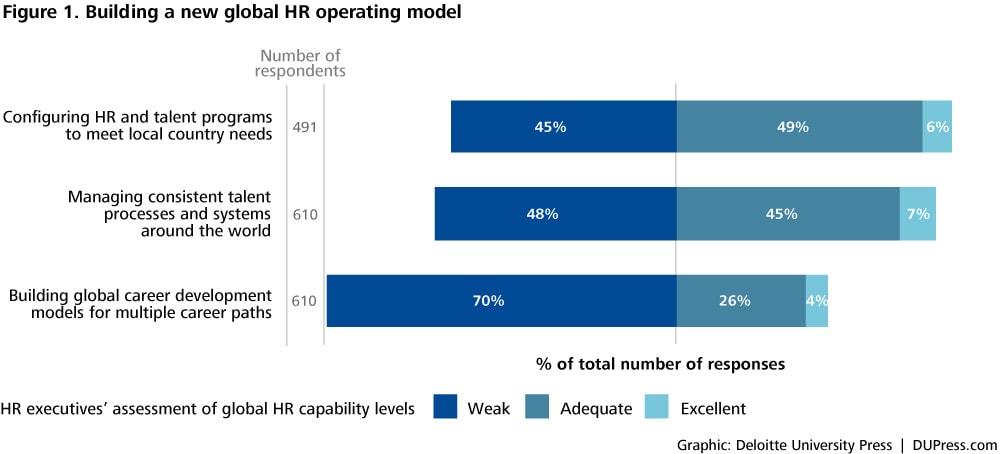The global and local HR function has been saved

The global and local HR function Balance scale and agility
08 March 2014
A new model of “high-impact” HR blends globalized talent practices for consistency and mobility with localized flexibility to attract, retain, and manage people appropriately.
- Business and talent strategies should be global in scale and local in implementation. Effective programs recruit, train, and develop people locally.
- Global HR and talent management is the second most urgent and important trend for large companies around the world (those with 10,000 or more employees), according to our global survey.
- Companies face the challenge of developing an integrated global HR and talent operating model that allows for customizable local implementation, enabling them to capitalize on rapid business growth in emerging economies, tap into local skills, and optimize local talent strategies.
Global businesses should have a global HR function. At the same time, in order to compete successfully in diverse markets, companies should recruit, train, and manage people locally—reflecting local culture, local labor markets, and the needs of diverse local business units.
Creating global standards, platforms, and service centers addresses only part of the challenge. Leading companies are developing HR operating models that are flexible enough to allow for local implementation and agile enough to adapt to local markets and business needs. The ultimate goal: to combine scale and agility to optimize talent management in every market where the company does business.
Explore the report findings
Launch the interactive trends dashboardCreate and download a custom PDF of the Human Capital Trends 2014 report.
The global side of the equation
For many organizations, one of the key drivers of a globally integrated HR strategy is the need for talent mobility within the company. Leading companies often move talent from region to region to address key talent gaps.
Consider a business unit in California with a strong need for engineering skills. The company may have a team in Moscow with precisely the right skills that has just finished a similar project. Unless the company’s talent practices are globally integrated, this match between business need and existing skills may never take place.
Companies operating on a global basis often offer high-potential employees global developmental assignments as one of their “tours of duty.” They also face the need to move specialists to global assignments rapidly. Globally integrated HR is critical to this process, but many companies do not have the systems in place to accomplish these increasingly common HR responsibilities.
In fact, when HR readiness was compared among more than 20 talent practices, the implementation of global mobility and career programs was among the lowest rated—more than 40 percent lower than the average for all other HR practices. More than two out of three executives (70 percent) rate their company’s ability to deliver on this need as “weak” (figure 1).
Adapting global HR to local talent marketplaces
While businesses today operate in a pervasively global environment when it comes to customers, talent, and supply chains, each local labor market has vastly different dynamics. To balance strong global HR strategies and platforms, companies should build flexibility and agility into HR so it can be customized for local markets.
The talent markets in Asia, for example, are far different from those in Western Europe and North America. Critical skills are in short supply; top candidates change jobs every nine to twelve months; salaries are increasing nearly 10 percent annually. To adapt to these conditions, talent strategies should focus on recruiting, rapid talent mobility, onboarding, and accelerated leadership development.
Of course, these variances are not limited to Asia. Localized challenges drive demand for local talent solutions in every region where a company does business. Labor regulations, compensation expectations, workplace culture, and many other factors vary significantly among regions. While global consistency and standards drive efficiency and scale, local flexibility powers growth and employee engagement. To achieve both, companies should move toward a new HR operating model.
When asked how well their companies are adapting HR and talent programs to local needs, executives were roughly split between “weak” and “adequate,” while less than 10 percent rated themselves as “excellent” (figure 1).
Moving from globally rationalized to globally optimized
For the past decade, many companies have been implementing a shared services model for HR to reduce global costs and improve service delivery. In most large companies, this “rationalized” model delivers tremendous benefits. It saves money, increases service to managers and employees, and provides global scale.
But for companies trying to recruit and optimize their teams in disparate markets, this shared services model is neither robust enough nor flexible enough to address the widely differing challenges that come from operating in dozens of individual markets.
How can companies aggressively recruit and build leaders in fast-growing Asian markets? How should organizations reskill and retain employees in Western Europe or the United States? What is the most effective strategy for developing talent in India? These and many other issues demand a balance of global standards that can be customized to fit local needs.
Addressing issues like these requires a shift from global rationalization to global optimization. Yet our survey found that many companies are struggling to adapt, particularly organizations in Brazil, Japan, and the United Kingdom (figure 2).
To make progress in this area, companies should focus on implementing an integrated HR operating model that centralizes critical core areas and empowers local HR teams to customize programs for local needs.
A high-impact global HR operating model
Our global survey shows that 81 percent of large organizations (10,000 employees or more) report that implementing an HR global operating model is “urgent” or “important” today. This urgent need aligns with our research into ways to create a high-impact HR operating model that combines global integration with local optimization. Key features of this model include:
- Implementing a global technology platform that provides common HR standards, frameworks, and tools
- Empowering local teams to innovate and to customize corporate programs
- Defining HR success not simply in terms of cost-cutting, but by HR’s ability to drive business performance and growth
Lessons from the front lines
Driving business change through HR integration
In 2010, a large financial services company began a business transformation that included significant investments to modernize the firm’s service infrastructure. This included the modernization of human resources policies, programs, and infrastructure to support new compensation and talent management programs, the development of global centers of excellence, regional shared services, and the implementation of global HR platforms—all aligned to support a globally integrated operating model with the flexibility to adapt to local needs.
This task was made more complex by the organization’s history of acquisitions and decentralized operations. As a result, HR had operations in over 90 counties and more than 200 HR and payroll systems. This decentralized operating structure made it difficult to meet the growing need for global HR data and processes for managing talent, performance, and compensation. The result was duplication of effort, high costs, HR service quality problems, and inadequate data for both HR and business-unit managers.
To lead the transformation of HR, the organization hired leaders and staff from the outside with experience doing similar projects for other large global companies. The program was ambitious. During the initial phase, an intense, thorough review of all HR systems confirmed the presence of a wide variety of unintegrated technological solutions and an unusually high-touch, local HR service delivery model—even by the standards of its industry. Based on this review, the company developed a design for a standard global HR operating platform supported by regional shared service centers.
A senior team of project managers focused on both global and local priorities—including designing new HR processes at both levels, building regional HR shared services centers, implementing global HR systems, and redesigning the operating model with a global emphasis. Larger countries participate fully in the new “targeted operating model,” which includes shared services. Smaller countries use an “express” version supported by a more locally delivered Workday solution.
With this global model in place, the initial phase of implementation focused on compliance, access to global HR data, platform rationalization, and associated cost reduction.
The company decided to launch its new model in Asia because its US operations already had shared services in place and a relatively standard, though old, operating platform. A new shared services center in Asia was followed by deployments in other regions, including a region comprising the Middle East, Africa, and Eastern Europe, and then a further rollout in Latin America.
In tandem with its global emphasis, the model also accounted for the critical importance of the local layer. The initial design phase included workshops on regional and, in several cases, country-specific requirements. Proposals for regional or local adaptations were referred back to the global HR organization for a thorough vetting process.
Simultaneously, a second aspect of the project’s global-local dynamic emerged as a key driver of success. In response to the perception that the effort was a US-driven global program, the project team shifted considerable responsibility and authority to regional HR transformation teams, while at the same time setting ground rules to retain the integrity of the new operating model. Making this change improved decision-making speed while also improving the perception and reality that regional and local HR teams were involved in the transformation.
The results have been impressive. To date, the transformation has consolidated over 70 legacy systems, reduced HR administrative work by 30 percent, improved compliance, and allowed HR services to more fully support the global alignment of the company’s businesses.
Where companies can start
A globally integrated, locally customized talent and HR strategy demands a combination of centralized, global standards and services coupled with distributed, highly trained experts. Our research suggests a clear set of starting points:
- Leverage global technology: Implement a common global technology platform to support the global HR organization and offer easy-to-use self-service capabilities to managers and employees.
- Rationalize core global services: Establish a core set of services for HR administration and talent communities of expertise. Encourage communities of expertise to learn from local business partners to determine leading practices in the field.
- Encourage country initiatives within global processes: Once global processes, roles, and expectations are created, expand the team to include communities of expertise and let local HR leaders create, customize, and deliver local programs. They can leverage the corporate infrastructure and standards to optimize talent strategies and HR programs in each business and geography, driving impact at the country level.
- Create deep specialists: Reduce the need for HR generalists and move them into the role of HR specialists, focused on recruiting, organizational development, employee relations, and compensation. These specialists can be located in or assigned to the business, but they should operate as a “network of expertise,” sharing skills with each other.
- Build HR “skill masters”: Invest in training, certifying, and developing the HR team to ensure that each member knows how to use all tools and data and feels connected to the larger community of leading practices and new ideas in the marketplace. Deep expertise belongs in HR no less than in other functions.
Bottom line
Global integration and local optimization are twin goals attainable through global technology platforms and proper role and process definition. Global consistency and standards ensure efficiency and scale; local flexibility drives agility, growth, and employee engagement. Both are necessary to develop an HR organization that is globally “fit for purpose.”
© 2021. See Terms of Use for more information.






